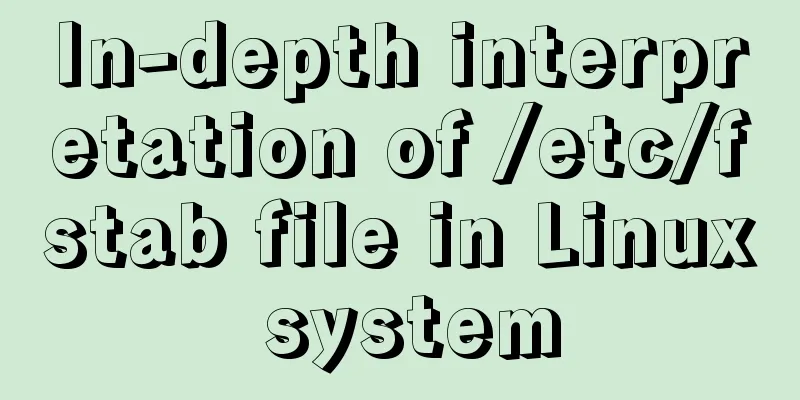In-depth interpretation of /etc/fstab file in Linux system

|
Preface [root@localhost ~]# cat /etc/fstab # # /etc/fstab # Created by anaconda on Sat Nov 3 12:03:31 2018 # # Accessible filesystems, by reference, are maintained under '/dev/disk' # See man pages fstab(5), findfs(8), mount(8) and/or blkid(8) for more info # UUID=64fc4e32-9cc9-4af9-8846-dc13865f770e / ext4 defaults 1 1 UUID=14c3958d-b0a9-41bd-a046-06e148013349 /boot ext4 defaults 1 2 UUID=15399f4c-8788-4348-b066-34179fe887cb swap swap defaults 0 0 tmpfs /dev/shm tmpfs defaults 0 0 devpts /dev/pts devpts gid=5,mode=620 0 0 sysfs /sys sysfs defaults 0 0 proc /proc proc defaults 0 0 The /etc/fstab file under the Linux system contains the records of the file systems that need to be automatically mounted after booting. When the Linux system starts, it will read this file to automatically mount the file system. We can set the file system to automatically mount at boot time by modifying this file. Let's interpret the specific meaning of the contents of this file. The first column: Device: disk device file or the Label or UUID of the device You can use the dumpe2label command to view the device label and UUID. Or use the simple command blkid command to view the UUId Note: The device name (/dev/sda) used to mount the partition is fixed. Once the order of the disk slots changes, the name will not match. Because the name will change. However, if you use label mounting, you don’t have to worry about the slot order. But always pay attention to your Label name. As for UUID, each partition will have a UUID as a unique identification number after being formatted. If you use UUID to mount, you don’t have to worry about confusion. The second column: Mount point: The mount point of the device, which is the directory you want to mount it to The third column: filesystem: the format of the disk file system, including ext2, ext3, reiserfs, nfs, vfat, etc. Fourth column: parameters: file system parameters, generally set to default: defaults Parameters that can be set under parameters:
Fifth column: Whether it can be affected by the dump backup command: dump is a command used for backup. Usually the value of this parameter is 0 or 1
The sixth column: Whether to check sectors: During the boot process, the system will use fsck to check whether our system is complete (clean) by default.
This is the meaning of all the fields in the /etc/fstab file. If we want to set the file system to automatically mount at boot, we can do so by modifying this file. It is important to note that after modifying the /etc/fstab file, when we no longer need to mount the file system and unmount it, we must modify the /etc/fstab file in time. Otherwise, when reading /etc/fstab to mount the unmounted file system during boot, an error will occur because the file system cannot be found, resulting in a failure to boot normally. Summarize The above is the full content of this article. I hope that the content of this article will have certain reference learning value for your study or work. If you have any questions, you can leave a message to communicate. Thank you for your support for 123WORDPRESS.COM. You may also be interested in:
|
<<: React hooks introductory tutorial
Recommend
MySQL 5.7.20 common download, installation and configuration methods and simple operation skills (decompression version free installation)
I just finished installing MySQL 5.7.19 in the ea...
Vue Page Stack Manager Details
Table of contents 2. Tried methods 2.1 keep-alive...
MySQL 8.0.12 Installation and Usage Tutorial
Recorded the installation and use tutorial of MyS...
Use docker to deploy tomcat and connect to skywalking
Table of contents 1. Overview 2. Use docker to de...
A brief discussion on the use of React.FC and React.Component
Table of contents 1. React.FC<> 2. class xx...
How to change the dot in the WeChat applet swiper-dot into a slider
Table of contents background Target Effect Ideas ...
SQL method for calculating timestamp difference
SQL method for calculating timestamp difference O...
React gets input value and submits 2 methods examples
Method 1: Use the target event attribute of the E...
Detailed explanation of vue.js dynamic components
:is dynamic component Use v-bind:is="compone...
Example code for CSS pseudo-classes to modify input selection style
Note: This table is quoted from the W3School tuto...
The difference between KEY, PRIMARY KEY, UNIQUE KEY, and INDEX in MySQL
The problem raised in the title can be broken dow...
v-html rendering component problem
Since I have parsed HTML before, I want to use Vu...
HTML table cross-row and cross-column operations (rowspan, colspan)
Generally, the colspan attribute of the <td>...
CSS automatically intercepts the specified length string and displays the end... Support FF browser
<style type="text/css"> Copy code ...
Use crontab to run the script of executing jar program regularly in centOS6
1. Write a simple Java program public class tests...









